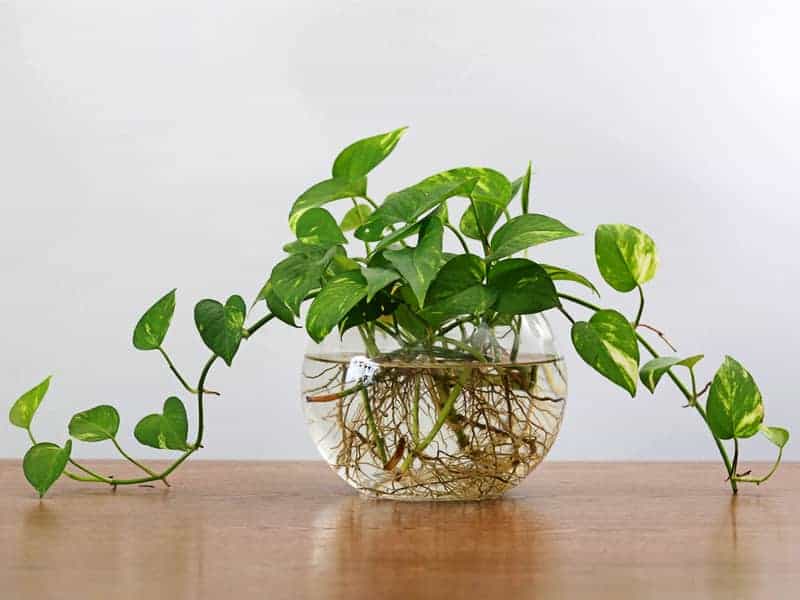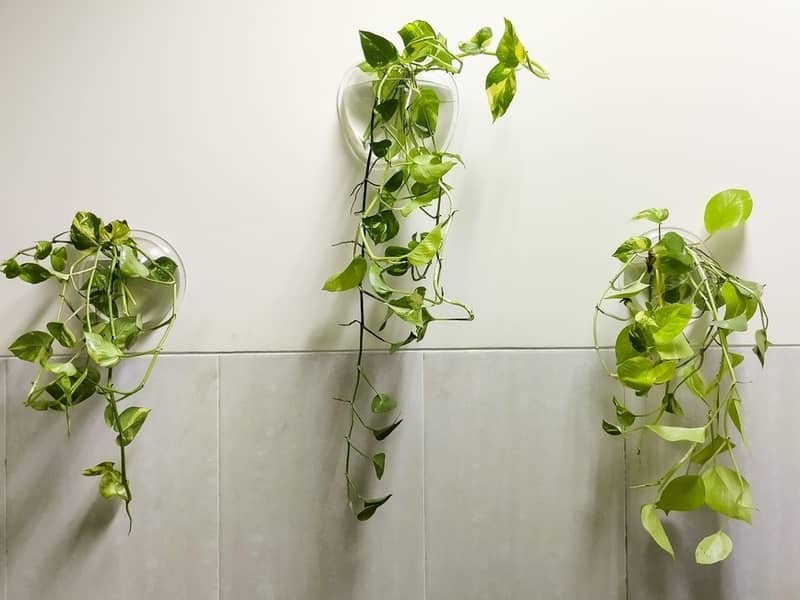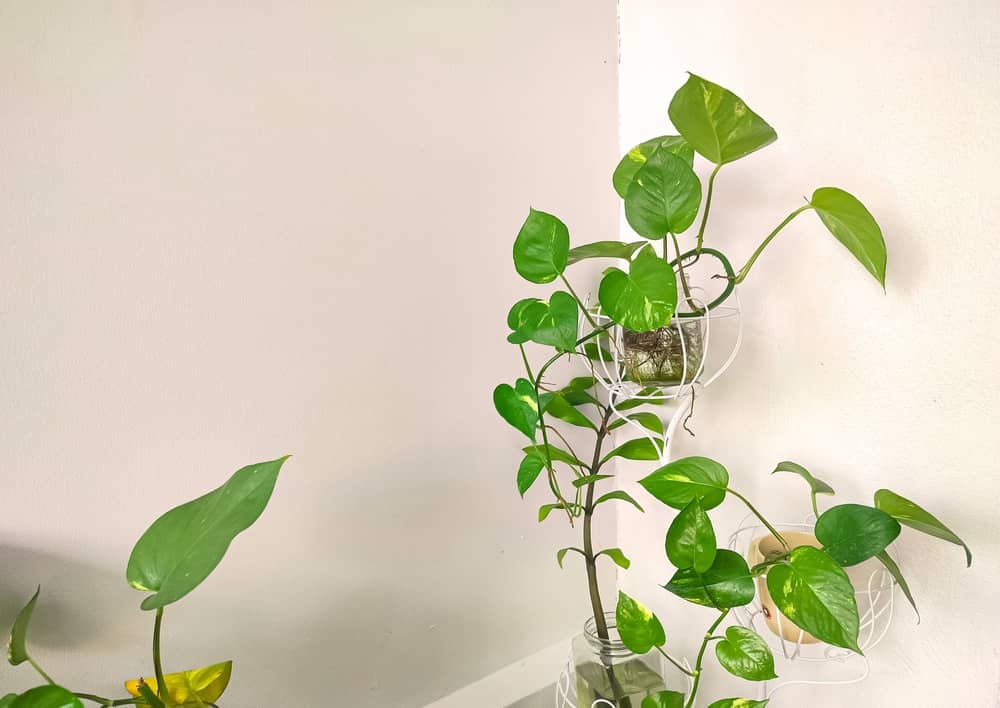Devil’s ivy doesn’t need much to thrive, and in the right conditions, it grows pretty fast. Looking at those long, leafy vines, you may wonder what to do with the bits you pruned off.
That’s easy — make more plants through propagation!
You can propagate your devil’s ivy via cuttings or layering. Both methods are straightforward, though cuttings give you more chances of success since you can take several of them.
Who says no to more plants for free? Start growing your indoor jungle by propagating another devil’s ivy or two, or three, or… Well, however many you want!
Preparing to Propagate | Where to Cut | Water Propagation | Soil Propagation | Perlite Propagation | Propagating by Layering | Care After Propagation
Before Propagating Devil’s Ivy: What to Know

Devil’s ivy (Epipremnum aureum, or the pothos plant) is really easy to propagate!
This vining plant has many leaf nodes or aerial roots along its stems, where new roots can emerge. A healthy cutting can put out growth in a few weeks.
Propagation is a great way to get new plants, especially for variegated pothos cultivars. Just keep in mind that there’s no guarantee the new plant will have the same variegation.
Try to take a cutting with several marbled leaves and some variegation on the stem, near the node.
If you’re propagating other plants, add a pothos cutting to the container! It’s said to release more hormones that help roots develop faster.
Preparing to Propagate Devil’s Ivy
The best time to take devil’s ivy cuttings for propagation is the growing season (spring and summer). But as indoor plants, you can cut off stems at any time of year.
If you’re pruning due to leggy or unruly growth, save some of those stems!
Water your plant a few days before you take the cuttings to minimise the stress.
Always use sharp, disinfected shears or pruners to lessen the risk of rot or disease. Spray a little rubbing alcohol or hydrogen peroxide onto the shears, then wipe them dry.
Avoid taking cuttings from vines with pests or disease. Still, you can “chop and prop” a dying mother plant, but only choose healthy vines and leaves.
Wear gloves while working, especially if you have sensitive skin — the sap can cause irritation!
How to Propagate Devil’s Ivy Cuttings
Like most indoor plants, devil’s ivy is usually propagated via cuttings. There are three popular mediums: water, soil, and perlite.
Where to cut devil’s ivy to propagate
Take your devil’s ivy cuttings from the end of a healthy stem (also called a “tip cutting”).
Each cutting should be around 10–15cm long, measured from the stem tip. Make sure there’s at least one leaf node or aerial root, or there won’t be anywhere for new roots to grow!
Try not to prune a vine with a new leaf emerging, so the cutting can focus its energy on root development instead.
With your shears, make one clean, angled cut between leaf nodes. Remove any leaves from the bottom part, leaving one or two near the top.
If you’re pruning the plant, you can divide one vine into several cuttings as long as each one has a leaf and a node!
How to propagate devil’s ivy in water

Water propagation is the most common method, since it’s simple and straightforward.
When propagating devil’s ivy in water, place the cuttings in a clear container. Add enough filtered water so the lowest nodes are submerged, but don’t let the water touch the leaves.
You can cover the opening with some plastic wrap, then poke some small holes to help hold the cuttings in place.
Place the jar in plenty of bright, indirect sunlight or under a full-spectrum grow light. Avoid direct sunlight, since this can cause excessive algae growth or overheat the water.
Change the water if it gets murky or if you see algae. Otherwise, you can top up as needed.
Devil’s ivy roots quickly in water, so you should see new growth within 2–4 weeks. When the growth is at least 5cm long with secondary roots, you can transfer the cuttings to potting mix!
Place the new plants in a small pot with chunky soil. Lightly tap the container to remove any air gaps, then water well to reduce the risk of transplant shock.
Keep the potting mix consistently moist (but not soggy) for 2–3 weeks so the roots can adapt to soil.
How to propagate devil’s ivy in soil
If you want to skip the water step, you can put devil’s ivy cuttings straight into soil!
Keep in mind that there’s a higher risk of rot due to moisture, so be sure to use a pot with drainage holes and a chunky, well-draining potting mix.
When propagating devil’s ivy in soil, leave the cuttings in a well-ventilated spot for an hour so the trimmed ends can heal. It’s optional, but you can dip the stem ends in some rooting hormone.
Fill a small container halfway with moist potting mix, then insert each cutting so that the lowest node is covered. Gently firm the soil to hold everything in place.
Keep the pot under bright, indirect light or a grow light. Make sure the soil mix stays lightly moist but avoid waterlogging, or the cutting could rot.
Devil’s ivy takes longer to root in soil, usually around 4–6 weeks. After a few weeks, very gently tug the plant at the base — if you feel resistance, it’s starting to root!
As new leaves come in, reduce watering to lessen the risk of rot.
How to propagate devil’s ivy in perlite

Besides water and soil, you can also propagate pothos in perlite!
There’s less risk of rot compared to soil, and the new growth will be less delicate than water roots. However, be careful when transplanting cuttings since new roots tend to grow into the perlite and can get pulled off.
Position a few cuttings in a small jar, then fill the space with moist perlite. Cover the opening with plastic wrap to keep in moisture.
Lightly mist the perlite every few days to keep it consistently moist. You should start seeing roots after several weeks, then you can transfer them directly to potting mix.
How to Propagate a Devil’s Ivy Plant by Layering
If you’d prefer not to take cuttings just yet, you can propagate your pothos “on the plant” by layering. This starts the rooting process from a node that’s still on the mother plant.
There are two ways to do this: air layering and soil layering.
Air layering
Choose a healthy devil’s ivy stem and count a few aerial nodes down from the tip. Make a tiny cut in your chosen aerial node or root with a clean blade, just enough to break the surface.
Lightly wrap the node in some damp sphagnum moss. Secure the moss with a propagation pod or wrap it in some plastic wrap and string.
Check every few days if the moss has dried out and mist it if necessary.
It may take up to 3 months for roots to emerge, so be patient. When there are thick, white roots around 5cm long, cut the stem below the roots and replant the cutting in a pot with soil.
Soil layering
Soil layering is a great way to fill in gaps inside a pot or make a devil’s ivy bushier! You just need some garden staples or pieces of wire bent into a U-shape.
Choose a moderately long, healthy vine with good aerial roots. Bend the vine so you can push the aerial roots into the surface of the potting soil, then secure it in place with the staples.
Keep the area around the buried vine lightly damp, but not too wet or the vine could rot.
Once you see the roots grow (or feel resistance when you tug), cut the stem on the side connected to the parent plant. You want to separate the stem so it can continue growing from the tip.
After Propagation: Devil’s Ivy Plant Care
After transferring a water propagation, you’ll need to keep the potting mix lightly but consistently moist.
Water-grown roots are delicate and will need an adjustment period as they start getting oxygen and nutrients from soil.
One trick is to add a little potting mix to the container of water every day until you’ve completely replaced the water. It’s more effort, but helps make the transition to soil easier.
After the cuttings have settled, it will take a while to see new leaf growth. The plant needs to focus its energy on establishing a strong root system first.
As the new plant matures, it’s important to follow proper devil’s ivy care! Give it lots of bright, indirect sun and water when the soil is mostly dry.
FAQs About Devil’s Ivy Propagation

Here are a couple more questions people often ask about propagating pothos plants!
Can you propagate pothos from leaves?
No, you cannot propagate a devil’s ivy plant from just a leaf or a nodeless stem.
Your cuttings must have some stem with at least one node or aerial root, where new growth will emerge. Without that, the leaf will eventually rot in the water.
Can devil’s ivy grow in water?
Yes! Devil’s ivy is a great indoor houseplant to grow in water permanently.
Instead of transferring your water propagations, just leave the cuttings to grow in their container. You’ll need to change the water every 1–2 weeks and regularly use a water-soluble fertiliser for nutrients.

